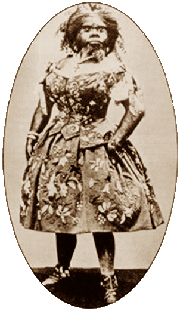Julia Pastrana
Julia Pastrana (* 1834 in Sinaloa , Mexico ; † 1860 in Moscow ) was an actress who appeared in a freak show (later generally called sideshow ) and became known as the "ape woman".
Life
The exact origin of Julia Pastranas can no longer be elucidated, according to some reports the child suffering from hypertrichosis was found together with his mother in a cave, bought from the mother and trained for show purposes. In later years Julia Pastrana was able to sing, dance and communicate in three languages, both verbally and in writing.
Julia Pastrana, who only reached a height of about 1.38 m, had other peculiarities in addition to her strong body hair. She had unusually large ears, a large nose, strongly protruding jaws and supposedly double rows of teeth. Her impresario Theodore Lent came up with the idea of presenting her to audiences on three continents as an "ape woman".
It is uncertain whether Theodore Lent married Julia Pastrana. On March 20, 1860, while on tour in Moscow, she gave birth to a child who was also affected by hypertrichosis and who died soon after birth. Julia Pastrana also only survived the birth by a few days.
Fate of the corpse
Lent initially left the two bodies to Professor Ivan Sokolow from Moscow University, who embalmed them. After being convinced of the success of this procedure, Lent bought the preparations back and went on with his trade - Julia Pastrana's body was presented in one of the costumes in which she usually appeared, the child next to her on a stand like a Parrot.
Around 1863 Lent found another woman with hypertrichosis named Maria Bartels near Karlsbad , who resembled Julia Pastrana. He married her and also included her in his show, pretending to be Zenora Pastrana , the sister of the dead. From 1871 until the bankruptcy in 1877, Lent ran a floating circus on the Rhine , in whose performances she was included and could be visited on the circus ship. He financed the large-scale circus in the form of a richly equipped Mississippi steamer. a. from exhibition receipts from Julia Pastrana's mummy, which was shown on loan in Vienna's Prater from 1871 and was given to the local showman Hermann Präuscher in 1873. Lent had previously performed with her in Germany.
Theodore Lent is said to have gone mad later and found shelter in a Russian institution, the second woman, alias Zenora Pastrana , survived and inherited him.
The prepared corpses of Julia Pastrana and her child were acquired by Haakon Lund in 1921, who presented them in his circus-like traveling show until 1943. In 1943 they were confiscated by the German occupation, but put on display again after the war. In 1970 the Norwegian government intervened, banned the public presentation and confiscated the bodies. After falling into the hands of a thief in 1979, they stayed in Oslo for many years and were used there for research and training purposes.
At the beginning of 2013, her mummified remains were transferred to her homeland, Mexico, to be buried in a dignified manner.
A planned film adaptation of Julia Pastrana's life with Richard Gere in the male lead was not realized.
Similar cases such as Tognina Gonsalvus have been published in Europe since the 17th century.
Individual evidence
- ↑ Lerma Garay, Antonio. Érase Una Vez en Mazatlán. Culiacan 2010
- ↑ Birgit Peter, Robert Kaldy-Karo: Artist life on forgotten ways: a search for traces in Vienna. LIT Verlag, Münster 2013, ISBN 3-64350499-3 , pp. 105–124; (Digital scan)
- ↑ Mainzer Abendblatt , No. 174, of July 27, 1871; (Digital scan)
- ↑ Late peace for Julia Pastrana. Article from April 28, 2016, in the Wiener Zeitung .
- ^ Daniel Saal: Richard Gere goes to the circus. spielfilm.de, February 25, 2000.
literature
- Christopher Hals Gylseth, Lars O. Toverud: Julia Pastrana. The Tragic Story of the Victorian Ape Woman . Sutton, Stroud 2003, ISBN 0-7509-3312-7 .
- Margrit Schriber : The ugliest woman in the world . Novel. Nagel & Kimche, Zurich 2009, ISBN 978-3-312-00446-1 .
Web links
- Bess Lovejoy. 2013. Julia Pastrana: A “Monster to the Whole World” , The Public Domain Review . (English)
- Picture and detailed life story (Spanish)
- Julia Pastrana - The Nondescript (English)
| personal data | |
|---|---|
| SURNAME | Pastrana, Julia |
| BRIEF DESCRIPTION | Mexican who has been referred to as the "monkey woman" or "the ugliest woman in the world" |
| DATE OF BIRTH | 1834 |
| PLACE OF BIRTH | Sinaloa , Mexico |
| DATE OF DEATH | March 1860 |
| Place of death | Moscow |

